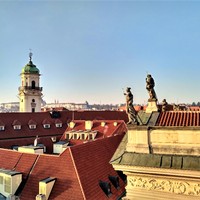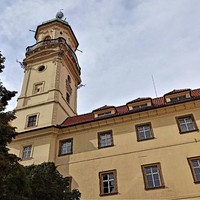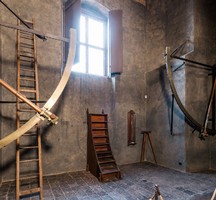Breadcrumbs navigation
The Clementinum Astronomical Tower (Astronomická věž Klementina)
One of the landmarks of the former Jesuit college is the Astronomical Tower, situated in the centre of the Clementinum courtyards. The height of the tower from the base to the top is 68 metres, the circular viewing balcony at 52 metres can be reached by climbing 172 steps. The top of the tower, visible from afar, is adorned with a lead statue of Atlas carrying a celestial sphere on his shoulders. Around 1750, an important phase of astronomical and climatic measurements and observations began here. You can get acquainted with many period astronomical instruments during a guided tour.
- Monuments & Architecture
- tower
- Baroque
Practical information
The tower is part of the sightseeing route The Clementinum Astronomical Tower and Baroque Library.
Contacts
- The Clementinum Astronomical Tower (Astronomická věž Klementina)
- Klementinum 190
- 110 00 Praha 1 – Staré Město
- +420221714714
Object history
The tower was completed in 1722, but unfortunately we do not know the name of its builder. The architect could have been František Maxmilián Kaňka or Kilián Ignác Dientzenhofer, while Anselmo Lurago, one of the most important architects of the Czech and Prague early Baroque, probably collaborated on the modifications.
The roof of the tower overlooks the monumental building complex of the Clementinum with the statue of Atlas from the workshop of Matyáš Bernard Braun. The 2.4 m high lead sculpture weighing 600 kg carries on its shoulders a celestial sphere, which is a historical astronomical instrument that was formerly used by astronomers and astrologers to measure and predict the positions of stars and planets in the sky and to tell the time. A tin plate discovered during the reconstruction of the dome in 1995 confirms the placement of the Atlas statue on the Astronomical Tower at the request of the rector of Prague University, later General of the Jesuit Order, František Retz, in 1723.
Thanks to Josef Stepling, the director of mathematical studies and co-founder of the Clementinum Observatory, the observation tower was originally equipped with astronomical instruments and so astronomical and meteorological measurements began here.
Several sundials adorned the walls of the Astronomical Tower, but only one on the eastern side has survived in its original form; the western side bears only a pointer (poles). The most valuable is the noon fibre or slotted sundial located in the Meridian Hall of the Astronomical Tower on the 2nd floor. Solar noon was thus determined by a thin beam of light that passed through a slit in the wall and merged with a string stretched on the floor.
For more than 80 years (1842-1928), a flag from the Astronomical Tower's gallery announced noon to the citizens of Prague. Since 1925 the exact time was broadcast from the Clementinum by radio, and therefore the noon signal from the tower lost its importance and on 31 January 1928 it was abolished.
An uninterrupted series of daily meteorological measurements was started thanks to Antonín Strnad on 1 January 1775. However, regular observations at least twice a day were already carried out by Josef Stepling, even with his own handmade instruments. In addition to temperature and air pressure, he recorded the amount of precipitation, the presence of clouds, the appearance of the sky, the strength and direction of the wind, thunderstorms and other weather events. Initially Stepling kept the instruments in his quarters, the exact location of which is not known. Later he placed them on the north side of the Astronomical Tower gallery and only under Antonín Strnad they were placed in the annex on the north side of the courtyard behind the Church of St. Clement, from where observations are still made today.
Information source: Prague City Tourism, Národní knihovna ČR







